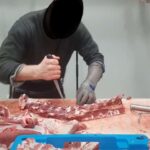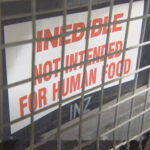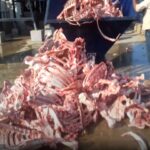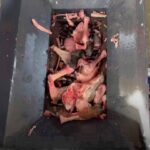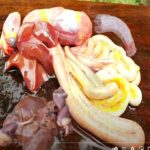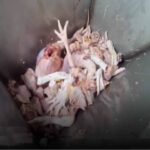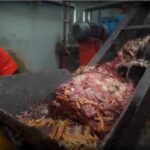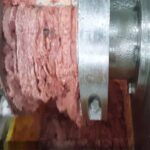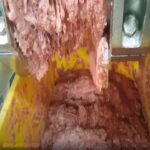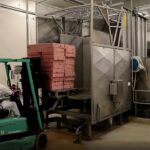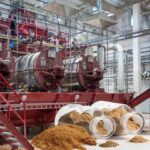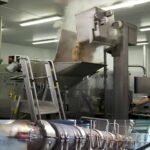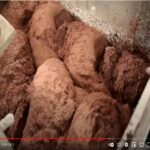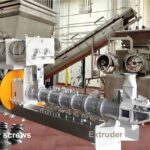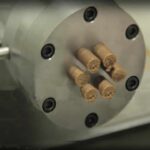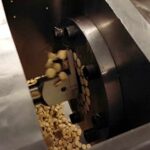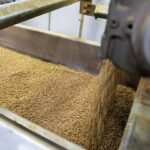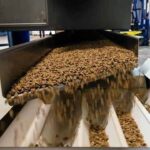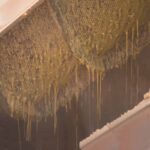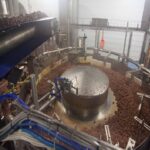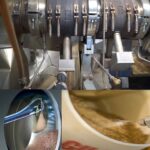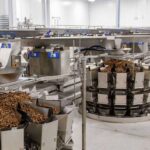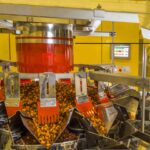The Meat In Your Dog And Cat’s Food – Where Did It Come From? – What’s Really In It?
Ron Hines DVM PhD
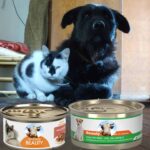 Additives & Preservatives In My Dog & Cat’s Food
Additives & Preservatives In My Dog & Cat’s Food
 Digestive Tract Issues And Why They Occur
Digestive Tract Issues And Why They Occur
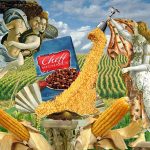

Major manufacturers of the foods you feed your pet know where their ingredients come from. But they guard that secret jealously. For them, it is preferable to side track you with, catchy phrases that mean nothing, and eye-catching graphics on their cans and sacs. The sacs cans, advertising and Washington lobbying cost more than what was inside the container you just purchased. But their strategy is highly cost-effective. Pet food The global pet food market is valued at ~ $99 billion in 2022. Quoting an article in a trade publication regarding pet parents – a term coined by the Industry for obvious reasons, “Many claims suggest that a product is more premium when it has advanced, elevated terms and descriptions, These are often called puffery claims in that they draw in the pet parent by the use of wording that speaks to them and that their product is better for your pet. This does not mean that necessarily a lot of research or scientific evidence or validation has come behind those claims. High in protein or nutrient-rich would be examples of what are often called puffery claims. Highly digestible is another one. Did you run digestibility trials?” It is a highly profitable deception.
Despite those eye-pleasing ingredient photos on the bag and the wolves, lynx, happy dogs and cats in their TV commercials, what actually goes into the bag or can doesn’t look at all like what you see on the sac. At best, the majority meat ingredients are the scraps, trimmings, offal (discards) and the very bottom end of the human food industry. How many pet food labels have you seen that said, “Made From USDA Human Grade Ingredients”? How many manufacturers state that their ingredients and processing procedures comply with FDA Title 21? or even the AAFCO’s own Standards for Human Grade Pet Products?
The only ones I would trust would be produced by firms whose CEO ate those products themselves on a regular basis. Honest, dedicated people such as Dick Van Patten. He is gone now, and his company, Natural Balance™, has passed on to other owners. Claims of human grade ingredients in the products are no longer made.
Here Are Some Of The Ingredients You Might See On The Labels:
Chicken, Beef, Pork, etc.
If the ingredient says chicken, beef, pork, venison, etc. and no other word such as by-product, meal, broth, appears before the next ingredient is actually muscle from that species. If the word for the meat is followed by words such as dinner, entrée, platter, formula, nuggets, flavor, or gravy, expect no more than 1-5% of the dry weight of that pet food to be that particular meat.
However, it does not mean that the animal that contributed it was fit for human consumption. Edible meat is too valuable for much of it to enter the pet food trade. Only the most expensive brands contain actual meat and even then, most only in small or moderate amounts. It could have been condemned for human consumption due to bruises, broken bones, cuts, lesions or discoloration. It could have been a “downer cow” one that could not stand for a multitude of reasons. In the case of chickens, these can also be “spent hens”, those killed ~2 years of age because their egg production has fallen off. Dairy cows that have ended their useful life are another source of less expensive meat. The most common causes are hoof disorders, udder infections, gastrointestinal disease, accidents, milk fever, (n = 73; 11%), milk fever and calving difficulties. (read here)
USDA rules § 309.13allows “Livestock with anasarca, ocular squamous cell carcinoma (after removal of neoplastic tissue “cancer eye”), emaciation, eosinophilic myositis, immaturity, nonseptic bruises and injuries, and sarcosporidiosis” to be diverted to non-human food use.
 Chicken Meal, Beef Meal, Pork Meal, etc.
Chicken Meal, Beef Meal, Pork Meal, etc.
This is usually meat residues that cling to the animal’s skeleton after as much meat as possible has been removed. Most of that salvaged meat ends up as the supermarket ground meat you buy, fast food ingredients or as the meat in the canned soups and broths destined for human consumption where it commands a considerably better price than in the pet food industry. But some might be present in high-end pet food products. If so, they would most likely be labeled as Human Grade ingredients to help justify the increased cost of the product, although your dog and cat do dream about those ingredients. (read here)
Beef Byproduct Meal, Chicken Byproduct Meal, Pork Byproduct Meal, etc.
Needless to say, these sort of ingredients generate rather strong odors before they are “sanitized” in the kibble manufacturing process. (read here & here) Some of these VOCs are quite toxic. (read here) Almost 30 percent of an animal’s live weight ends up as offal, which would be expensive to dispose of and wasted if not for the rendering process. In the rendering process, the melted fat is separated from the solid portion through draining and pressing, and the remaining solid material is ground into powder. Anywhere from one-third to one-half of each animal produced for meat, milk or eggs is not consumed by humans. About 49% of the live weight of cattle, 44% of the live weight of pigs, 37% of the live weight of broilers and 57% of the live weight of fish are materials that are not fit to be consumed by humans. The volume of that material generated each year worldwide is ~ 54 billion pounds.
When chicken carcasses are the byproduct source, they are composed of the low-value discards of chicken slaughter, primarily necks, heads, skins, intestines, developing eggs and reproductive tract, etc. Not feathers. The 6th photo above shows this offal being ground up. It is a stock photograph. Chicken paws are no longer considered offal. They command a price of $3.50 per pound in mid-2022, so you are not going to find them in byproduct meal anymore.
Beef and pork products deemed unfit for human consumption can also be re-routed to the pet food industry. For example, pig livers found to be damaged by infestation. (read here & here)
More About The Byproducts In Dog And Cat Food
Most of the byproduct meal products arrive at dog and cat food production mills already in a dried, powdered form. In that form, they take up much less space, produces fewer odor complaints from surrounding residences, require less refrigeration and attract fewer flies. But I am told that in some plants, meat meal still arrives wet. The large amount of ground bone generated in the carcass grinding process can be separated out through centrifugation, sedimentation, or sieving; But advanced meat/bone separation (AMR) systems can also be used.
The Mixing & Extrusion Or Baking Process
All the ingredients are first thoroughly mixed in their dry form, in standard dog and cat foods, the majority of those ingredients are agricultural plants, grain and/or starchy vegetables. Whatever dried animal tissues is generally the next most plentiful ingredient. Then come minor ingredients. Many of those, such as flower petals and spices are added to catch your eye, vitamins are added in excess since portions of all of them will be inactivated at the extreme temperatures required to bond the kibble pellets together. Only the oily ingredients call palatants (flavor enhancers) are left out to be sprayed as a kibble coating later. Once water is added, it becomes a dough. The dough enters a machine (an extruder) in which it is steamed at high temperature (250F +) and pressure while augers keep the mixture stirred. During that process the starch products such as corn, wheat, potatoes, peas, etc. change structurally to bind the entire ingredients together. (read here) At that point, the mass is forced farther along down the extruder barrel to a set of dyes that have holes of the same diameter as the finished kibble pellets. The second photo above shows that die. The next photo shows the revolving blade that shears the pellets to their proper length.
known as an extruder, which cooks the dough under pressure. The dough exits the extruder under pressure through a die plate creating ribbons of pre-specified shapes that are then sliced into the pre-specified size using a rotary cutter. After extrusion and cutting, the kibbles are air dried in an oven to remove moisture and then cooled. Reducing the moisture content is an important step in maintaining freshness and preventing food spoilage. When baked, the dough is rolled out and cut into shapes, then baked in an oven (similar to cookies or biscuits). Until pet owners became more knowledgeable, corn was the most common “glue” in kibble. Powdered most corn gels at 140-172.4 F/60-78 C. When the machine is operated at the higher range of temperatures (200-250 F), bacteria and mold are more likely to be killed, and the mix becomes more plastic. But more vitamins and nutrients are lost. When lower-end temperatures are used “resistant”, less digestible starch is formed. That can have effects on your pet heath. Because resistant starch is less likely to cause a blood glucose surge. (read here) Another danger that high-carbohydrate pet foods present.
These doughs can also be baked. Baked kibble is growing in popularity. Machines modified from the cookie baking industry can process up to 20,000 pounds of dough/hour, matching high-pressure extruders. Pet food manufacturers tout baked over extruded or vice versa, depending on which one they sell. Baking doe allows more variety in kibble shape and texture, which can be an important consumer draw.
Fats, Sprayed-On Oils and Flavor-Enhancers = Palatants
If your cat or your dog’s food doesn’t look good or smell good when you get home, you aren’t going to buy that brand again. And if your dog or cat won’t eat it, you won’t buy it again either. So, ingredients that pet food companies refer to as palatants are vital for their economic success. Along with the eye-pleasing kibble dyes and the eye-catching graphics on the sacs, they are a vital part of the Industry. When dealing with the public, they often refer to palatants as “flavor enhancers”. The industry sells more dry kibble than canned pet food. That is because of the public’s preference for long shelf life (no need to refrigerate opened cans), lesser expense, but most of all, convenience. The trade-off is that kibble products that are often less attractive to dogs and cats than moist or semi-moist diets. (read here & here) How their food smells is extremely important to dogs and cats. Many palatants work by introducing odors that dogs and cats (or the aroma of rosemary for their owner’s) find pleasant by masking underlying odors. Color dyes are important too. Pet owners are unlikely to buy kibble pellets that they deem too small or dies that appear too dark a brown to them or an oily feel get a thumbs down. (read here)
Industry focus groups identified a number of dry dog food odors that they considered objectionable, they included “barnyard”, “vitaminy”, “rancid”, “cardboard”, “musty/dusty” and “stale”. The most positive smell was described as “meaty”. The industry can get away with more taste deficiencies in dogs than in cats. Dogs are, by nature, gluttonous feeders. Their wild predecessors quickly devoured prey when the opportunities arose, taking little time to chew and savor. They might then regurgitate it latter when away from the competing pack. Cats, being solitary, could take their time.
Palatants to deal with these problems are generally sprayed on kibble in a liquid form after baking. Those commonly used on dog kibble differ from the ones commonly sprayed on cat chow. They often represent ~2% of the kibbles weight. Many of those palatants are animal digests derived from waste products of the beef, pork, poultry, or fish industry – the remaining oily liquids left over from the production of meat byproduct meals I mentioned earlier. Or produced in sprayable form from the livers, lungs, blood, stomachs, intestines, spleen, kidneys and brains, feet and heads of domestic livestock and poultry. Others are protein hydrolysates with agreeable tastes. Those include lysine & l-methionine. Many of those original amino acids in red meat were destroyed during the complicated and extensive kibble production process. Even the extensive carbohydrate content of the kibble can have a positive effect on taste when, as the kibble cooking, temperatures rises above 300F/149C and triggers the maillard reaction. This is not necessarily a good thing for your dog or cat. (read here & here) Animal fat (lard) obtained during livestock rendering also adds palatability and, like carbohydrates, keeps kibble production costs down. That is why such a large amount of antioxidants had to be added to the kibble dough to retard spoilage and rancidity. They aren’t there for your pet’s health benefits.
Sacking
Like their ingredients, most sacking bags you purchase did not originate in North America. The last two photos are screenshots from the Alibaba website. As Liu Zhidong said through a translator. “When burnt, they produce poisoning smoke, and if buried underneath the ground they need more than 300 years to be degraded.” To the best of my knowledge, none of them are biodegradable. The only biodegradable feed sacks are manufactured by Cargill with the BPI logo.
Are There Possibly Contaminants In My Dog Or Cat’s Food?
Yes,
Farm animals, nearing the end of their lives, are more likely to end up as dog and cat food than in your cuisine. Those could be old or injured dairy cows and other cattle. When the cost of their treatment becomes greater than the animal’s value, a rancher’s next stop is usually the local auction barn. If they pass USDA inspectors at the slaughterhouse, those animals generally represent the USDA’s lowest beef grades. The liver is where ingested toxins tend to accumulate. (read here) Many hog livers deemed unfit for human consumption end up in pet food as well. (read here) The “wash-out time” (time it takes for drugs to leave its body) for pain-relieving NSAIDs is considerable. (read here & here) It is not known if the processing temperatures used to create pet kibble are high enough to destroy these and similar compounds. A common one that veterinarians administer in North America, and that farmers around the world purchase at feed stores is flunixin (Banamine®). 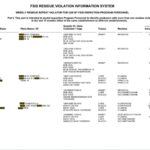
At US livestock sale barns, they are described as “non-ambulatory cattle” Studies have found them about nine times more likely to contain these drug residues than ordinary beef cattle. When these old beef cattle are culled by ranchers, it is usually because of one of the “three Os” open (=missed her pregnancy), ornery (mean) or old. At slaughter, they end up in the “Grade D but edible” classification – mostly in dog and cat food. None, to the best of my knowledge, are screened for drug residues.
If you inquire of your pet food manufacturer where the meat ingredients in your dog or cat’s diet originated, and they answer, “We source globally”. Assume that some or all originated in the leading meat-exporting nations, Brazil, India, China, or Argentina. All nations with lower food safety standards than the United States, Canada, UK or the EU. (read here)
That is also how contaminants such as melamine end up in their exported food products. (read here)
Another potential problem with highly processed, high temperature denatured products such as dry and canned dog and cat food is the generation of Heterocyclic amines (HCAs) and polycyclic aromatic hydrocarbons (PAHs) (read here) HCAs are created in larger amounts when creatinine and amino acids in meat react together under high temperatures (392 F/200 C). But the process can begin at 212 F/100 C). Fat content also influences their creation. (read here) You might want to ask your pet food supplier what temperature their kibble reaches during extrusion and if they check each batch for HCAs and PAHs. Let me know their answer.
That is why I am more comfortable when your dog and cat eat the same supermarket meat and other ingredients that you eat and prepared for it at home.
You are on the Vetspace animal health website
Visiting the products that you see displayed on this website help pay the cost of keeping these articles on the Internet.

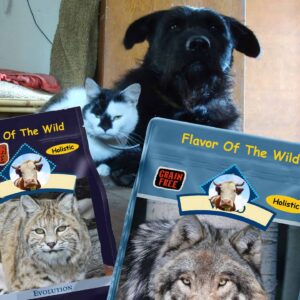
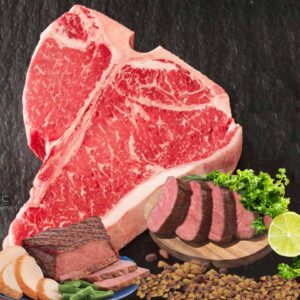
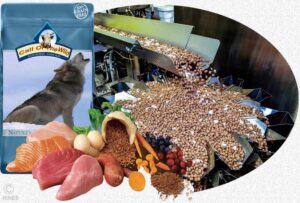

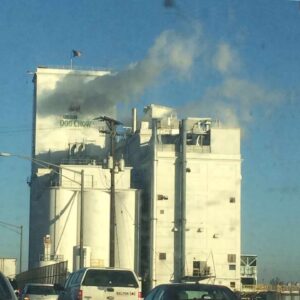

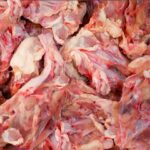
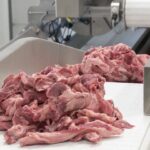
 Chicken Meal, Beef Meal, Pork Meal, etc.
Chicken Meal, Beef Meal, Pork Meal, etc.